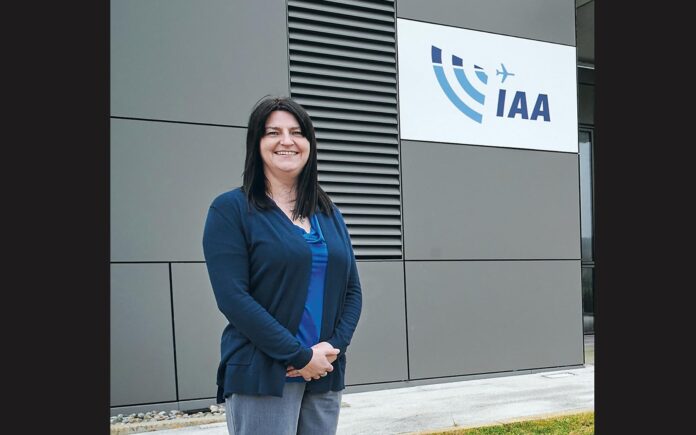FOR two police officers in New Mexico, in February, their fate was in the hands of the search and rescue teams who found them, when their aircraft crashed.
A similar situation faced a businessman in 2019, when his aircraft crashed in the middle of the ocean.
All three were successfully rescued and returned to safety, thanks in no small way to the team at the IAA North Atlantic Communications Centre in Ballygirreen.
Using the latest technology, they were able to direct the search and rescue crews to the exact locations of the crashed aircraft.
One member of that team is Paula Quinn, who has 12 years’ experience in the sector, firstly as radio officer and now as a watch manager.
Paula explains that it is vital the locations of all aircraft are monitored at all times and that until recently, it was difficult to get exact, real-time locations for aircraft flying over the oceans.
“Monitoring of these aircraft relied solely on land-based radar systems, which only covered 30% of the globe. So, air traffic teams kept in contact with the aircraft flying through the remaining 70% through High Frequency (HF) radio.
“Once the aircraft enters the airspace monitored by us, the captain makes contact with us on HF radio. The communication with the aircraft takes place every 15 or 16 minutes,” Paula explains.
The difficulty with this land-based system is that providing search and rescue teams with exact accuracy is difficult, as the aircraft travels great distances in 15 minutes.
However, accurately pinpointing aircraft is now possible. In 2019, the team at Ballygirreen was selected to manage and operate the innovative Aireon Alert system.
Using space-based technology, rather than land-based radar, it locates aircraft almost instantly, anywhere in the world. It is free of charge and available 24 hours a day for search and rescue operators, airlines and air traffic control services.
The IAA is a partner with Aireon, the company responsible for the research and development of the system. Paula was responsible for designing the systems for the Aeronautical Radio Officers operating Aireon Alert.
She also developed and implemented the training programme for the operators assigned to Aireon Alert.
“It covers areas that your ground-based systems wouldn’t be able to cover, over deserts, very mountainous areas, over oceans.
“It’s not a land-based system, it’s actually satellite-based so it provides 100% global coverage,” she said.
Now, when those carrying out a search get in touch, much more can be done.
“We would be given information by whoever contacted us, it could be a Search and Rescue organisation, they would give us the call sign of the aircraft or the IP of the aircraft and we have a database that we can type that information into and it will give us a return on the location of the aircraft, to the last 15 minutes of the flight.
“There’s a report for every minute, from 15 minutes down to the last minute, and depending on where the aircraft is, we could get a position report up to every eight seconds from the last minute of flight.
“It gives a very accurate location of where the aircraft is, the direction, the rate of descent, things like that.”
Working in a sector that has generally been very male-dominated, she doesn’t feel she has experienced any significant gender related issues.
“Everybody was incredibly supportive, very welcoming and I never had any difficulties.”
On her career progression, she says, “I started as a trainee in 2009, qualified in 2010 as a radio officer, held that position until I was promoted to watch manager about four years ago.”
Unquestionably, her work carries more pressure and responsibility than most.
“Is it a very stressful job? A lot of it depends on what you’re dealing with. It’s a very responsible job, I think that would be the way to put it.
“We always have to be very mindful that if there was to be an emergency situation or anything like that we have to make sure that we’re copying all of the information very accurately and in a very timely fashion taking it to air traffic control.
“You’re always conscious that it is a very responsible job and that you’re dealing with pilots and passengers.”
It is a job where it is very important to be able to keep your head and focus on what needs to be done, she says.
“Certainly, having a calm disposition is a skill that you would require. Being able to assess the situation and understand the status of a situation or an issue, knowing that you could be under pressure from a time point of view.
“You want to make sure that all the information that you’d either copying from the pilot or delivering to the pilot is correct, and you want to make sure that you are delivering the information accurately or quickly.
“We need to be good communicators, need to have effective communication, and also very effective listening skills in order to be able to accurately copy information. Which means that we need to be able to recognise terms to do with aircraft equipment, so a very broad aviation knowledge is required, as well as being very specifically trained for the role.”
Whatever pressures are there, she really takes a lot pleasure from what she does.
“I absolutely love it, absolutely love it, always loved the role of a radio officer, and since becoming a Watch Manager I’ve been involved in different projects.
“There’s a management side and its opened up a whole new world within aviation for me. I love the challenge of that role as well and learning more and more about the world of aviation.”
Owen Ryan has been a journalist with the Clare Champion since 2007, having previously worked with a number of other publications in Limerick, Cork and Galway. His first book will be published in December 2024.


